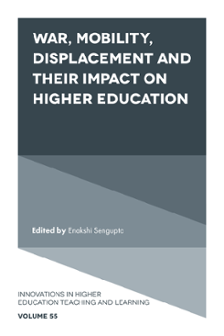
Subject Index
War, Mobility, Displacement and Their Impact on Higher Education
ISBN: 978-1-80455-435-7, eISBN: 978-1-80455-434-0
ISSN: 2055-3641
Publication date: 22 July 2024
Citation
(2024), "Subject Index", Sengupta, E. (Ed.) War, Mobility, Displacement and Their Impact on Higher Education (Innovations in Higher Education Teaching and Learning, Vol. 55), Emerald Publishing Limited, Leeds, pp. 147-151. https://doi.org/10.1108/S2055-364120240000055012
Publisher
:Emerald Publishing Limited
Copyright © 2024 Enakshi Sengupta
INDEX
(see also Disrupted education)
- Prelims
- Part I: Adapting to Changes
- Introduction to War, Mobility, Displacement and Their Impact on Higher Education
- Chapter 1: Translanguaging and Mobility in Higher Education Institutions: Challenges and Strategies
- Chapter 2: Strategies of Advocating for Female Afghan Students' Right to Education on the Twitter Social Media Networking Site After the Taliban's Takeover of Afghanistan in 2021
- Chapter 3: The Higher Educational Processes in a Context of Migration and Displacement in Ecuador
- Chapter 4: Dreams Not Crushed, Just a Little Wrinkled: Navigating a Disrupted Education
- Chapter 5: Team Based Learning: An Inclusive Learning Methodology to Increase Engagement and Integration of Diverse Student Groups
- Chapter 6: Investigating International Students' Contributions to Their HEIs: Local and International Students' Perspectives in Oman
- Part II: Displacement of Students
- Chapter 7: Wartime Education Mobility and Displacement: An Observation of Challenges Faced By Students and Their Future
- About the Editor
- About the Contributors
- Name Index
- Subject Index